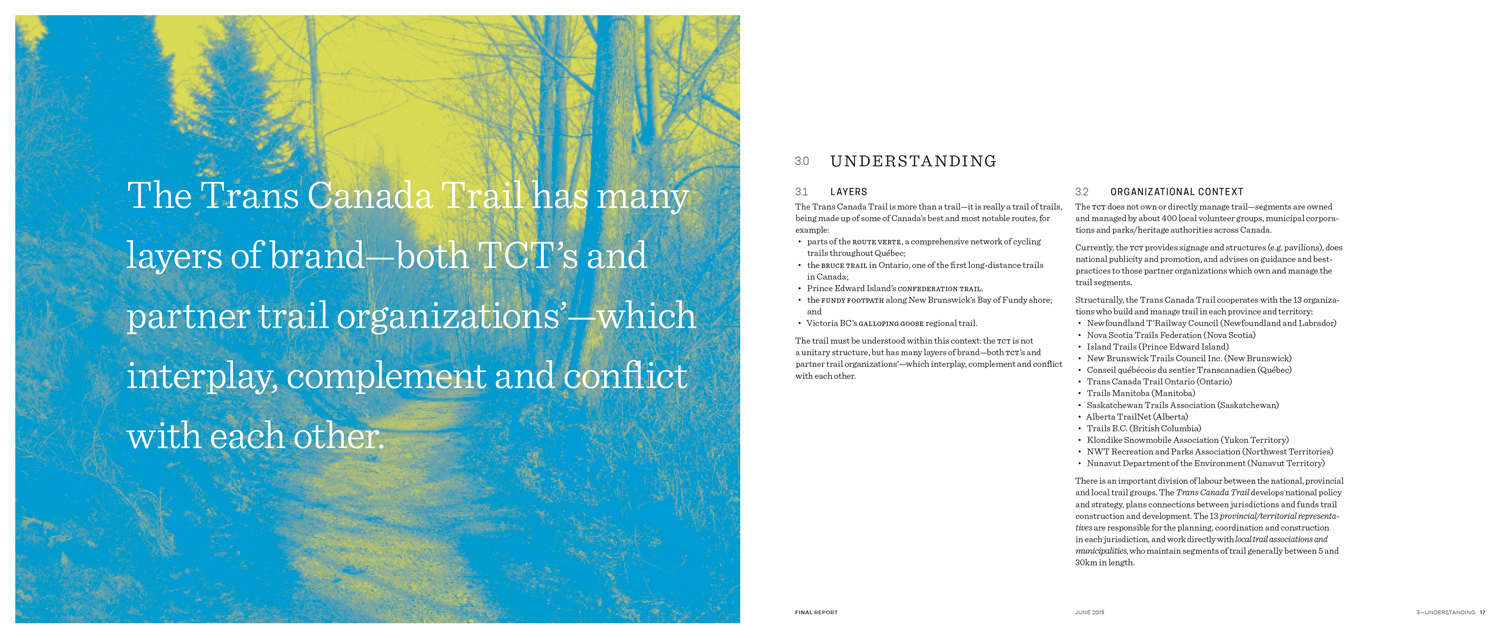Trans Canada Trail
Trans Canada Trail
How to sign 24,000 km of trail?
The Trans Canada Trail (TCT) presented us with a unique challenge: how do you sign the longest trail in the world? What if that trail is not a single entity, but owned and managed by hundreds of stakeholders, including private owners, volunteers, and municipal, provincial and federal governments and agencies?
Inspired by other long-distance trails, such as the Camino de Santiago (Spain) and the Appalachian Trail (USA), we advised the TCT to make better use of the biggest marketing asset it has—the trail itself—to inspire people. Signs should make trail users feel like they are travelling on the longest trail in the world, no matter where they are: urban, suburban, rural, or way out in the vast Canadian wilderness.
Our signage strategy was adopted as TCT policy in 2015.
Status
2014–15 (strategy)
Our Role
strategy, branding, wayfinding, graphic design
Client
Trans Canada Trail
Location
Canada, Coast to Coast to Coast
Details
24,000 km trail
TRAIL TYPES
We had to take into account the diversity of trail types the TCT has to offer across the country: from urban streets, to wilderness single-track, to river and lake waterways. Signage needed to work inter-modally, and make the continuity of the TCT clear to trail users.
CASE STUDIES
When complete, the TCT will be the longest trail in the world, which puts it into a class of its own. Nonetheless, we were inspired by several storied long-distance trails across the world, like the Camino de Santiago (Spain) and the Appalachian Trail (USA).
UNDERSTANDING
Every great project begins with identifying the problems to be solved. Form:Media went out to explore the TCT and experience the trail as any pedestrian or cyclist might. We compared policy and implementation, and interviewed stakeholders, partners and users to see where priorities lie.
BRAND ANALYSIS
Our analysis included a look at whether the TCT was fulfilling its brand promise. Did the trail feel like the longest trail in the world? Would a trail user getting on to walk in St. John's feel like they could just keep on going to Vancouver or Tuktoyaktuk (if they wanted to?)
THE CURRENT SYSTEM
The TCT has thousands of existing assets on the trail across Canada: signs and various commemorative structures. We looked for opportunities to re-use or modify things that are already in the ground to save on costs and administrative burden.
EXISTING CONDITIONS
Because TCT signs are located and installed by trail partners, we found a wide variety: some signs did their job, and some didn't.
CASE STUDIES 2
Each case had something else to offer. The Camino de Santiago had a mythological pull, but it only became a popular secular route in the 20th century. The Appalachian Trail offered extreme challenges in wilderness areas, but appealed to Americans of all stripes. The Great Alleghany Passage (Pennsylvania) offered a clear, well signed trail experience. Loire à velo (France) presented tourists with safe easy cycling routes, and made trip planning easy. Lastly, the National Tourist Routes (Norway) added architectural interventions to complement the landscape and focus visitors' interest on Norway's system of tourist highways.
BRAND OPPORTUNITIES
We recommended a set of badges which allowed the TCT to be itself: a family of interconnected regional trails rather than a unitary 24,000 km linear pathway. The badges would allow the TCT to balance regional needs with its own national brand.
LINEAR PARKWAY
We saw the Trans Canada Trail as most trail users see it: a series of linear routes which connect communities across Canada. We wanted to be able to give it a legible structure like a big-city subway map.
“The Form:Media team were a pleasure to work with, and remained responsive and flexible throughout the process. We are very pleased with the results of this collaboration, and have engaged Form:Media to continue with the next phase of this project.Lori Spence, Vice-President, COO, Trans Canada Trail”
CREDIT
Photo: [banner] courtesy of Trans Canada Trail.










